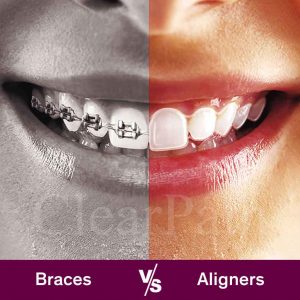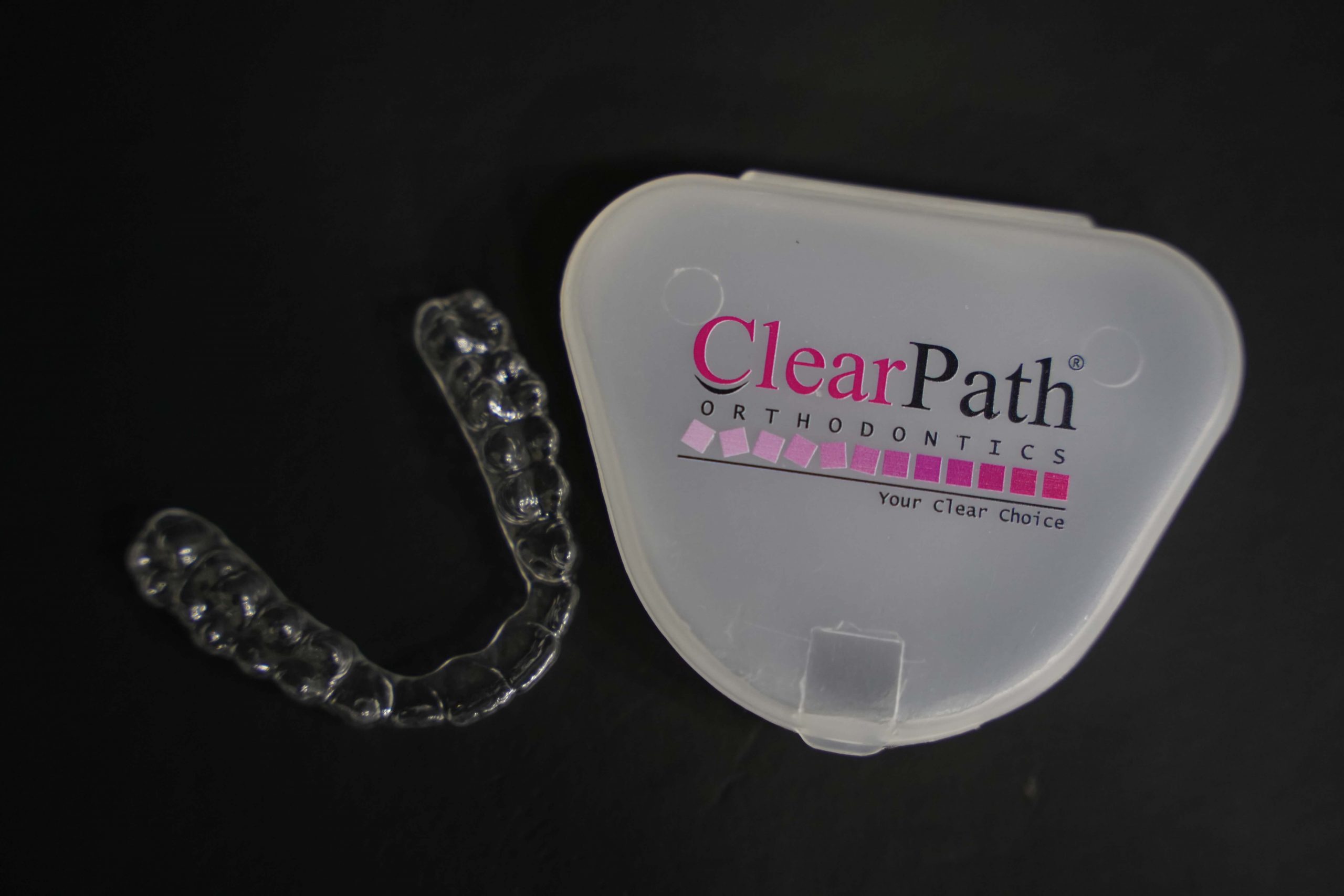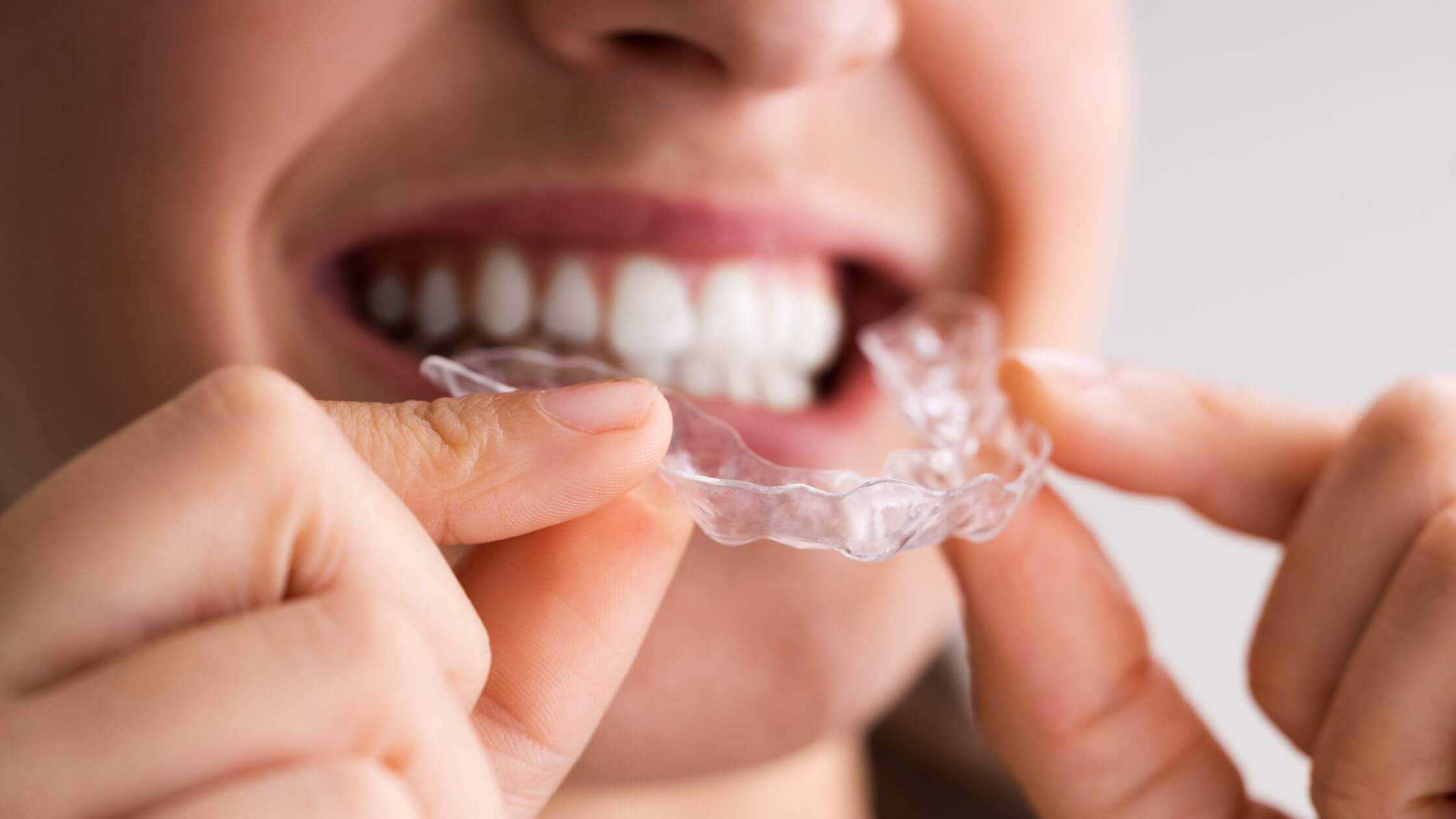Embarking on the journey to a straighter, more confident smile is a transformative process. Aligners and braces are your steadfast companions on this course, working their magic to realign your teeth and equip you with that dazzling smile you’ve always dreamed of 😉
But let us channel our inner Spider-Man here:
The power of orthodontic devices comes with the responsibility of diligent oral hygiene!
Dental floss might not be the hero you expected, but it emerges as a game-changer in the quest to keep your teeth, braces, aligners, or even retainers immaculately clean.
These orthodontic marvels, while shaping your dream smile, can inadvertently become traps for food particles and plaque. 😬
Left unchecked, this food debris can culminate in tooth decay, gum disease, and unwelcome bad breath. Dental floss, an unassuming hero in your oral hygiene routine, plays a pivotal role in preventing these daily dental woes from turning catastrophic.
But then comes a series of questions:
- How do you effectively floss with aligners or braces in the equation?
- What type of floss should you employ?
- And are there alternatives for those who find traditional flossing a challenge or even uncomfortable?
Flossing with braces, in particular, does present unique challenges as you navigate through the intricate landscape of wires and attachments that hold them in place.
Read on as we discuss all these consequential things in detail.
Table of Contents
ToggleIs Dental Floss (Generally) Good for Teeth?

Absolutely!
It’s a thin thread designed to reach those tight spaces between your teeth and remove stubborn food particles that your toothbrush can’t reach. Dental floss, in turn, checks bacterial buildup and plaque formation from becoming severe, nipping them in the bud.
Flossing regularly, further, can help prevent cavities, gum inflammation (a solid cause of braces pain), and bad breath.
The Importance of Flossing with Aligners: A Breakdown
Here’s the list:
Defeating Debris: Flossing becomes your vigilant partner, ensuring the eviction of persistent food bits and plaque from the crevices between your teeth and beneath your gum line – zones off-limits to your trusty toothbrush.
Gums Get a Boost: Beyond mere debris removal, flossing provides your gums with a workout, enhancing blood circulation. This strengthens your defenses against inflammation and the lurking threat of infections.
Natural Teeth Polish: A delightful perk of dedicated flossing is its natural polishing effect on your teeth. This little extra can help keep your smile bright and healthy – an aesthetic advantage your invisible braces can build on.
Fresh Breath: Flossing isn’t just about looks; it’s about forming a comprehensive oral hygiene routine. By eliminating trapped debris and plaque, you also reduce the population of odor-causing bacteria, resulting in a fresher breath.
As per the American Dental Association (ADA), a date with your dental floss should occur at least once a day, preferably before your toothbrushing ritual.
With aligners and braces, the flossing guideline/regime comes as an imperative!
Tape vs. Floss: What Types of Dental Floss Should You Use?

In the world of dental floss, the choices abound but can be neatly divided into two main contenders: Floss and Tape.
Dental Floss
With its streamlined design, it’s the preferred pick for people with teeth that are cozily close. This versatile player offers a range of flavors, textures, and materials, including waxed, unwaxed, nylon, silk, and user-friendly dental floss picks.
Yet, while elegant, a gentle heads-up – dental floss can be a tad delicate. It may snap or fray, especially when faced with sharp edges on your teeth or braces. For the latter, some patients have reported needing to use teeth pain tablets to relieve the soreness caused by flossing scrapes. With clear aligners, however, the risk of this happening is reduced since you take them off before doing any flossing action.
Dental Tape
The broader, more robust sibling. This stalwart is the recommended option for individuals with wider gaps between their teeth, efficiently covering more ground. Dental tape is tough, taking on dental challenges without breaking a sweat. But there’s a twist. Its thickness may not sit well with everyone, making it a bit challenging to use comfortably. It may also lag behind in the plaque-removal department compared to its sleeker counterpart.
The best course, however, is a matter of personal preference and comfort.
For those seeking expert counsel for their dental care with aligners, our certified orthodontists can offer invaluable guidance on the optimal choice for your unique needs.
Further Considerations
Selecting the right dental floss isn’t merely a casual choice, especially when it comes to braces or aligners.
It requires thoughtful consideration in six key areas:
Thickness and Texture: Striking a balance is key. Dental floss should be thin enough to navigate tight spots yet sturdy enough to avoid breaking or shredding.
Flavor and Coating: Preferences vary, from minty freshness to fruity delight. Waxed or unwaxed coatings can make flossing easier.
Shape and Design: Consider the floss’s shape that best suits your dental landscape. Flat or round floss adapts to different tooth contours and gap sizes.
Tooth Gap Size: If your teeth are closely packed, traditional dental floss could be your hero. For wider gaps, dental tape might save the day.
Comfort: Your ease of use should weigh heavily. Some find traditional floss easier to handle, while others prefer the broader reach of dental tape.
Braces or Dental Work: Braces can make flossing a little tricky. In such cases, dental tape may offer smoother sailing. You might still need a floss threader for both options to navigate braces.
Types of Dental Floss
The three major types commercially available are:
Traditional Floss: This classic floss, available in various flavors and colors, is affordable and straightforward. It can be tricky to maneuver behind brace wires.
Dental Tape: Similar to traditional floss but broader, dental tape is suitable for those with wider gaps between teeth. Using it behind brace wires might require the assistance of a floss threader.
Superfloss: Specially designed for brace wearers, it features a stiff end, eliminating the need for an extra threader. The spongy segment is perfect for thorough cleaning around brackets and aligner attachments. When coupled with the cost of aligners, though, this option can be a bit expensive.
Don’t be afraid to give each type a try to see which suits you best. But always under orthodontic guidance, of course.
Alternatives Beyond Dental Floss: What Else Can I Use?

If you’re finding traditional flossing a bit challenging or uncomfortable with your aligners or braces, you’re in luck because there are great alternatives that can help you maintain excellent oral hygiene in both cases.
Other Options
Interdental Brushes: These sleek soldiers feature a wire stem and bristles determined to infiltrate the tight gaps between your teeth. They’re user-friendly and come in various shapes and sizes.
Water Flossers: This is your arsenal if you prefer a water blitz to tackle plaque and debris. They’re adept at reaching tight spots and gentle on your gums and teeth, but they have a few undesirable quirks – a tad bulky, a bit noisy, and a touch pricey.
Dental Picks: These simple sticks with pointed tips scrape off plaque and debris. They’re affordable and ultra-convenient. But their cleaning action is point-restricted.
Oral Irrigators: Combining air and water power, these cousins of water flossers go easy on your gums and teeth while tackling tough spots.
These alternatives offer another path to maintain your oral health, bypassing the hassle of traditional flossing.
The Art of Flossing: Which method is best?
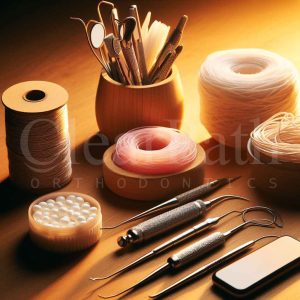
Flossing is a science-backed art that, when done right, can save your teeth and aligners from a world of trouble.
Here’s a step-by-step of using it right:
STEP 1 – Choose Your Weapon
Begin with the right tool – dental floss or tape, as recommended by your orthodontist. Cut about 18 inches of floss.
Pro tip: wrap it around your middle fingers, leaving a 2-inch space between them.
STEP 2 – Thread the Needle
For braces or aligners, a floss threader is essential. Slide it under the wire, gently threading it between two teeth.
STEP 3 – The Gentle Slide
Now, the magic unfolds. Slide the floss between your teeth with a gentle back-and-forth motion. But remember, no snapping through haste! Proceed gently.
STEP 4 – Wrap and Glide
Form a ‘C’ shape around each tooth, gently gliding it up and down. Pay special attention to your gums, being delicate to avoid irritation. Ensure you clean both the sides of your teeth and the gum line.
STEP 5 – Fresh & Unwound
Move from tooth to tooth, using a fresh section of floss for each one. Using the same one might spread bacteria and plaque.
STEP 6 – Rinse and Repeat
After your flossing quest is complete, rinse your mouth with water to sweep away any dislodged particles. Or opt for mouthwash for that extra minty freshness.
Don’t forget, if flossing feels like a battle with aligners or braces, call in reinforcements like an interdental brush or a water flosser to aid you in cleaning around the brackets and wires.
How deep should I floss?
When tackling flossing around braces, precision is paramount.
Here are the nooks and precautions you want to pay special attention to:
- Beneath the Wires: Ensure you navigate beneath the wires. Thoroughly clean both the upper and lower sides of the wire to remove trapped debris.
- The Right Resistance: Floss until you feel a subtle resistance from your gums. Avoid excessive depth that might lead to pain or bleeding.
- Gumline Guardians: Floss around each tooth, ensuring the thread or tape dips below the gumline. The keys to success here are a gentle touch and patience, guaranteeing a comprehensive cleaning.
Which is Superior: Dental Floss or Tape?

There is no definitive answer to whether dental floss or tape is better, as different people may have different preferences and needs.
But here’s our dental floss vs dental tape chart to put the matter in plain relief.
| Features/Characteristics | Dental Floss | Dental Tape |
|---|---|---|
| Structure | Slender and round, resembling a thin thread. Various materials e.g. nylon and Teflon. Can be either waxed or unwaxed. Can also come in the form of floss picks | Broader and flat, like a ribbon. Typically made from Teflon or polyethylene, both waxed and unwaxed. Has an advantage in covering wider gaps between teeth |
| Thickness | Generally thinner, making it ideal for tight spaces between teeth or braces | Thicker, better suited for people with wider gaps between their teeth |
| Strength and Durability | Relatively strong and durable. Can break if applied to rough dental surfaces | Thicker and more robust. Can withstand the challenges of cleaning braces more effectively |
| Ease of Use | Challenging to maneuver behind brace wires. A floss threader may be necessary | Easier to insert in wide tooth spaces and around braces |
| Personal Preference | Some may find dental floss more suitable due to their small dental gaps | Others may prefer dental tape due to large gaps |
The Bright Side of the Affair: Does flossing make teeth whiter?
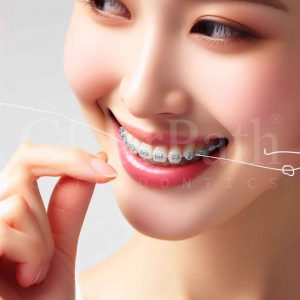
Flossing isn’t just about removing food particles; it’s your path to brighter, whiter teeth.
Here’s what you need to know about this particular flossing perk:
Plaque Peril: Plaque, that sneaky bacterial film, can cause tooth decay and discoloration. Flossing combats this.
Defying Stains: Your morning coffee, that evening glass of red wine, or tobacco can darken your teeth with stains. This can become a real – aesthetic – problem if you put on your clear aligners without thorough brushing and flossing after each culinary session.
Preserving Whiteness: While flossing won’t give you an instant Hollywood smile, think of it as the guardian of the natural calcium whiteness you already possess.
Beyond Floss
For more dramatic cleaning results, consider whitening products like toothpaste, strips, gels, or trays. These can take your teeth whitening journey to the next level – the perfect complement to your dental alignment treatment with aligners or braces.
What if my gums bleed while flossing?
Bleeding gums signal tissue inflammation, often due to inadequate cleaning. But don’t fret; this is a solvable issue. Keep flossing gently, and the bleeding will subside as your oral hygiene improves. Also, it usually doesn’t hurt to load up on your daily Vitamin C (following your dentist’s guidelines).
Which is Easier – flossing teeth with clear aligners or braces?

Flossing with clear aligners is a breeze compared to flossing with braces, and this is why:
Flexibility: Clear aligners are simple to wear, and you can take them out anytime. Simply pop them out, floss your teeth as you normally would, and pop them back in. It’s that simple.
No Hurdles: Unlike braces, clear aligners won’t throw hurdles in your flossing routine. Braces require extra cleaning tools – but not aligners.
A Healthier Smile: The convenience of flossing with clear aligners means you’re more likely to stay committed to your oral hygiene. This can lead to healthier gums and lower risks of gum disease and cavities.
The Research Supports Clear Aligner Use for Optimal Gum Health
Flossing during clear aligner treatment may offer unique advantages in terms of cleaning ease and effectiveness when contrasted with traditional braces, as suggested by research:
- A study by Gu et al. (2017) found that clear aligner patients scored significantly higher in oral health-related quality of life using the OHIP-14 questionnaire.
- In a survey by Weir (2017), 83% of orthodontists reported better oral hygiene and fewer issues with gum health and enamel for clear aligner patients.
- A review by Rossini et al. (2015) revealed that clear aligners had lower plaque, gingival inflammation, and decalcification rates.
These findings suggest that clear aligners might offer superior oral hygiene benefits.
Both aligners and braces, however, require proper cleaning, care and guidance from an orthodontist for optimal straightening results.
More FAQs
- Is dental floss safe for braces and aligners?
Yes, dental floss is safe for both braces and aligners. But you should be careful to avoid damaging them. Use a floss threader to navigate under the wires.
- How often should I floss with braces or aligners?
Floss at least once every 24 hours, preferably before bedtime, to remove food particles and plaque that can accumulate during the day.
Convinced that Clear Aligners are Better for Your Oral Hygiene and Want to Book?
That’s easy!
Just fill out the form below ✍ – our friendly customer service reps will take care of the rest:
Get you connected with our certified panel of orthodontists, who’ll even recommend the best dental floss for cleaning your teeth.
And answer all your teeth straightening/smile beautifying (ClearPath Ortho’s treatment forte) queries, of course 😊.






